Third-Generation Thermodynamic Descriptions for Ta-Cr and Ta-V Binary Systems
Abstract
:1. Introduction
2. Thermodynamic Model
2.1. A2 and Liquid Solution Phases
2.2. C14 and C15 Laves Phases
3. Results
3.1. The Third-Generation Gibbs Energy Expressions for Pure Cr and V
3.2. Thermodynamic Descriptions of Ta-Cr and Ta-V Binary Systems
4. Conclusions
- The third-generation Gibbs energy expressions of pure Cr and V in both the liquid and A2 phases were established. By applying these expressions, the thermodynamic properties down to 0 K and thermal vacancy near the melting point can be well described. Besides, the lattice stability of Cr and V over the whole temperature range can be guaranteed.
- Based on the third-generation Gibbs energy expressions of pure elements, the Ta-Cr and Ta-V binary systems were thermodynamically assessed by considering the reviewed phase equilibria and thermodynamic data with the CALPHAD approach. A strategy to estimate the Gibbs energy of Laves phase was proposed by combining the theoretically computed and experimentally measured thermodynamic properties as well as semiempirical relation. Such a method was applied to C14 and C15 Laves phases in Ta-Cr and Ta-V binary systems. The calculated phase diagrams and thermodynamic properties showed nice agreement with the measured ones. Significant improvements can be observed at low temperatures compared with those from the second-generation thermodynamic descriptions, indicating the high reliability of the present thermodynamic descriptions.
Author Contributions
Funding
Institutional Review Board Statement
Informed Consent Statement
Data Availability Statement
Conflicts of Interest
References
- Senkov, O.N.; Wilks, G.B.; Miracle, D.B.; Chang, C.P.; Liaw, P.K. Refractory high-entropy alloys. Intermetallics 2010, 18, 1758–1765. [Google Scholar] [CrossRef]
- Senkov, O.N.; Miracle, D.B.; Chaput, K.J.; Couzinie, J.-P. Development and exploration of refractory high entropy alloys—A review. J. Mater. Res. 2018, 33, 3092–3128. [Google Scholar] [CrossRef] [Green Version]
- Miracle, D.B.; Tsai, M.-H.; Senkov, O.N.; Soni, V.; Banerjee, R. Refractory high entropy superalloys (RSAs). Scr. Mater. 2020, 187, 445–452. [Google Scholar] [CrossRef]
- Couzinié, J.-P.; Senkov, O.N.; Miracle, D.B.; Dirras, G. Comprehensive data compilation on the mechanical properties of refractory high-entropy alloys. Data Brief 2018, 21, 1622–1641. [Google Scholar] [CrossRef] [PubMed]
- Qin, G.; Li, Z.; Chen, R.; Zheng, H.; Fan, C.; Wang, L.; Su, Y.; Ding, H.; Guo, J.; Fu, H. CoCrFeMnNi high-entropy alloys reinforced with Laves phase by adding Nb and Ti elements. J. Mater. Res. 2018, 34, 1011–1020. [Google Scholar] [CrossRef]
- Yi, J.; Wang, L.; Xu, M.; Yang, L. Microstructure and mechanical properties of refractory high-entropy alloy HfMoNbTiCr. Mater. Techol. 2021, 55, 305–310. [Google Scholar] [CrossRef]
- Yao, H.W.; Miao, J.W.; Liu, Y.M.; Guo, E.Y.; Huang, H.; Lu, Y.P.; Wang, T.M.; Li, T.J. Effect of Ti and Nb contents on microstructure and mechanical properties of HfZrVTaMoWTixNby refractory high-entropy alloys. Adv. Energy Mater. 2021, 23, 2100225. [Google Scholar]
- Stein, F.; Palm, M.; Sauthoff, G. Structure and stability of Laves phases. Part I. Critical assessment of factors controlling Laves phase stability. Intermetallics 2004, 12, 713–720. [Google Scholar] [CrossRef]
- Yurchenko, N.; Stepanov, N.; Salishchev, G. Laves-phase formation criterion for high-entropy alloys. Mater. Sci. Technol. 2017, 33, 17–22. [Google Scholar] [CrossRef]
- Yao, H.; Qiao, D.; Miao, J.; Wang, J.; Guo, E.; Lu, Y. Criteria for laves-phase formation in refractory high-entropy alloys. Phil. Mag. Lett. 2021, in press. [Google Scholar] [CrossRef]
- Gao, M.C.; Carney, C.S.; Doğan, Ö.N.; Jablonksi, P.D.; Hawk, J.A.; Alman, D.E. Design of refractory high-entropy alloys. JOM 2015, 67, 2653–2669. [Google Scholar] [CrossRef]
- Raturi, A.; Aditya, J.; Gurao, N.P.; Biswas, K. ICME approach to explore equiatomic and non-equiatomic single phase BCC refractory high entropy alloys. J. Alloys Compd. 2018, 806, 587–595. [Google Scholar] [CrossRef]
- Zhang, E.K.; Tang, Y.; Wen, M.W.; Obaied, A.; Roslyakova, I.; Zhang, L.J. On phase stability of Mo-Nb-Ta-W refractory high entropy alloys. Int. J. Refract. Met. Hard Mater. 2022, 103, 105780. [Google Scholar] [CrossRef]
- Chase, M.W.; Ansara, I.; Dinsdale, A.; Eriksson, G.; Grimvall, G.; Hoglund, L.; Yokokawa, H. Group 1: Heat capacity models for crystalline phases from 0 K to 6000 K. Calphad 1995, 19, 437–447. [Google Scholar]
- Roslyakova, I.; Sundman, B.; Dette, H.; Zhang, L.J.; Steinbach, I. Modeling of Gibbs energies of pure elements down to 0 K using segmented regression. Calphad 2016, 55, 165–180. [Google Scholar] [CrossRef] [Green Version]
- Bigdeli, S.; Mao, H.H.; Selleby, M. On the third-generation Calphad databases: An updated description of Mn. Phys. Status Solidi B 2015, 252, 2199–2208. [Google Scholar] [CrossRef]
- Hao, L.Y.; Ruban, A.; Xiong, W. CALPHAD modeling based on Gibbs energy functions from zero kevin and improved magnetic model: A case study on the Cr-Ni system. Calphad 2021, 73, 102268. [Google Scholar] [CrossRef]
- Tang, Y.; Zhang, L.J. Effect of thermal vacancy on thermodynamic behaviors in BCC W close to melting point: A thermodynamic study. Materials 2018, 11, 1648. [Google Scholar] [CrossRef] [Green Version]
- Obaied, A.; Bocklund, B.; Zomorodpoosh, S.; Zhang, L.J.; Otis, R.; Liu, Z.-K.; Roslyakova, I. Thermodynamic re-assessment of pure chromium using modified segmented regression model. Calphad 2020, 69, 101762. [Google Scholar] [CrossRef]
- Ågren, J. Thermodynamics of supercooled liquids and their glass transition. Phys. Chem. Liq. 1988, 18, 123–139. [Google Scholar] [CrossRef]
- Jiang, Y.X.; Zomorodpoosh, S.; Roslyakova, I.; Zhang, L.J. Thermodynamic re-assessment of binary Cr-Nb system down to 0 K. Calphad 2018, 62, 109–118. [Google Scholar] [CrossRef]
- Jiang, Y.X.; Zomorodpoosh, S.; Roslyakova, I.; Zhang, L.J. Thermodynamic re-assessment of the binary Cr–Ta system down to 0 K. Int. J. Mater. Res. 2019, 110, 797–807. [Google Scholar]
- Arblaster, J.W. Thermodynamic properties of vanadium. J. Phase Equilib. Diffus. 2017, 38, 51–64. [Google Scholar] [CrossRef]
- Chekhovskoi, V.Y. The energy of formation of vacancies and their concentration in chromium. Sov. Phys. Solid State 1979, 21, 1089–1090. [Google Scholar]
- Chekhovskoii, V.Y.; Tarasov, V.D.; Grigoreva, N.V. Contribution of equilibrium vacancies to vanadium caloric properties. High Temp. 2011, 49, 826–831. [Google Scholar] [CrossRef]
- Anderson, C. The heat capacities of chromium, chromic oxide, chromous chloride and chromic chloride at low temperatures. J. Am. Chem. Soc. 1937, 59, 488–491. [Google Scholar] [CrossRef]
- Estermann, I.; Friedberg, S.A.; Goldman, J.E. The specific heats of several metals between 1.8 and 4.2 K. Phys. Rev. 1952, 87, 582–588. [Google Scholar] [CrossRef]
- Kemeny, T.; Fogarassy, B.; Arajs, S.; Moyer, C.A. Heat-capacity studies of chromium-rich antiferromagnetic chromium-iron alloys. Phys. Rev. B 1979, 20, 2975–2979. [Google Scholar] [CrossRef]
- Beaumont, R.H.; Chihara, H.; Morrison, J.A. An anomaly in the heat capacity of chromium at 38.5 °C. Phil. Mag. 1960, 5, 188–191. [Google Scholar] [CrossRef]
- Kohlhaas, R.; Braun, M. Die thermodynamischen funktionen des reinen eisens: Wärmeinhalt und spezifische wärme austenitischer eisenlegierungen und stähle. Arch. Eisenhuttenwes 1965, 34, 391–399. [Google Scholar] [CrossRef]
- Armstrong, L.D.; Grayson-Smith, H. High temperature calorimetry: II. Atomic heats of chromium, manganese, and cobalt between 0° and 800 °C. Can. J. Res. 1950, 28, 51–59. [Google Scholar] [CrossRef]
- Kalishevich, G.I.; Krentsis, R.V. The standard specific heats, entropies, and enthalpies of silicon and chromium and its alloys. Zh. Fiz. Khim. 1965, 39, 2999–3001. [Google Scholar]
- Krauss, F. Die messung der spezifischen wärme von metallen bei hohen temperature. Z. Metallkd. 1958, 49, 386–392. [Google Scholar]
- Martin, D.; Newton, R.F.; Girmes, W.R.; Blankenship, F.F. Activities in the chromium-nickel system. J. Phys. Chem. 1958, 62, 980–982. [Google Scholar]
- Simon, F.; Simson, V.C.; Ruhemann, M. An investigation on the specific heat at low temperature, the specific heat of the halides of ammonia between −70 °C and room temperature. Z. Phys. Chem. 1927, 129, 339–348. [Google Scholar]
- Clusius, K.; Franzosini, P. Ergebnisse der tieftemperaturforschung. XXXII. Atom-und elektronenwarme des chroms zwischen 14 K und 273 K. Z. Naturforsch. 1962, 17, 522–525. [Google Scholar] [CrossRef] [Green Version]
- Rayne, J.A.; Kemp, W.R.G. The heat capacities of chromium and nickel. Phil. Mag. 1956, 1, 918–925. [Google Scholar] [CrossRef]
- Jaeger, F.; Rosenbohm, E. The exact measurement of the specific heats of metals at high temperatures. XVII. Calorimetric retardation phenomena in the case of cerium and chromium. Proc. Acad. Sci. Amst. 1934, 37, 489–497. [Google Scholar]
- Touloukian, Y.S.; Saxena, S.C.; Hestermans, P. Thermophysical Properties of Matter-the TPRC Data Series, 11; Ho, C.Y., Ed.; Thermophysical and Electronic Properties Information Analysis Center: Boulder, CO, USA, 1975; pp. 61–62. [Google Scholar]
- Lin, R.; Frohberg, M. Enthalpy measurements of solid and liquid chromium by levitation calorimetry. High Temp. High Press. 1988, 20, 539–544. [Google Scholar]
- Bendick, W.; Pepperhoff, W. The heat capacity of Ti, V. and Cr. J. Phys. F Met. Phy. 1982, 12, 1085–1090. [Google Scholar] [CrossRef]
- Cezairliyan, A.; Righini, F.; McClure, J.L. Simultaneous measurements of heat capacity, electrical resistivity and hemispherical total emittance by a pulse heating technique: Vanadium, 1500 to 2100 K. J. Res. Natl. Bur. Stand. A Phys. Chem. 1974, 78A, 143–147. [Google Scholar] [CrossRef] [PubMed]
- Clusius, K.; Franzosini, P.; Piesbergen, U. Ergebnisse der tieftemperaturforschung. XXXII. Die atom und elektronwarme des vanadins und niobs zwischen 10 and 273 K. Z. Naturforschg. 1960, 15A, 728–734. [Google Scholar] [CrossRef]
- Filippov, L.P.; Yurchak, P. High temperature investigation of the thermal properties of solids. Inzh. Fiz. Zh. 1971, 21, 561–577. [Google Scholar] [CrossRef]
- Kohlhaas, R.; Braun, M.; Vollmer, O. Die atomwarme von titan, vanadin und chrom im berich hoher temperature. Z. Naturforsch. 1965, 20A, 1077–1079. [Google Scholar] [CrossRef]
- Takahashi, Y.; Nakamura, J.-I.; Smith, J.F. Laser flash calorimetry. III. Heat capacity of vanadium from 80 to 1000 K. J. Chem. Thermodyn. 1982, 14, 977–982. [Google Scholar] [CrossRef]
- Conway, J.B.; Hein, R.A. Enthalpy measurements of solid materials to 2400 °C by means of a drop technique. In Advances in Thermophysical Properties at Extreme Temperatures and Pressures; Cratch, S., Ed.; The American Society of Mechanical Engineers: New York, NY, USA, 1965; pp. 152–155. [Google Scholar]
- Lucks, C.; Deem, H. Thermal Conductivities, Heat Capacities, and Linear Thermal Expansion of Five Materials. Wright Air Development Center; Report No. WADC-TR-55-496; Wright-Patterson Air Force Base: Dayton, OH, USA, 1956. [Google Scholar]
- Schimpff, H. On the heat capacity of metals and intermetallic compounds. Z. Phys. Chem. Neue Folge 1910, 71, 257–300. [Google Scholar] [CrossRef]
- Schübel, P. Metallographische mitteilungen aus dem institut für physikalische chemie der universitat gottingen. lxxxvii. Über die warmekapazitat von metallen und metallverbindungen zwischen 18–600 °C. Z. Anorg. Chem. 1914, 87, 81–119. [Google Scholar] [CrossRef]
- Umino, S. On the latent heat of fusion of several metals and their specific heats at high temperatures. Sci. Rep. Tohuku Imp. Univ. 1926, 15, 597–617. [Google Scholar]
- Kaufman, L. Coupled thermochemical and phase diagram data for tantalum based binary alloys. Calphad 1991, 15, 243–259. [Google Scholar] [CrossRef]
- Dupin, N.; Ansara, I. Thermodynamic assessment of the Cr-Ta system. J. Phase Equilib. 1993, 14, 451–456. [Google Scholar] [CrossRef]
- Pavlů, J.; Vřeštál, J.; Šob, M. Re-modeling of Laves phases in the Cr–Nb and Cr–Ta systems using first-principles results. Calphad 2009, 33, 179–186. [Google Scholar] [CrossRef]
- Danon, C.A.; Servant, C.A. Thermodynamic evaluation of the Ta-V system. J. Alloys Compd. 2004, 366, 191–200. [Google Scholar] [CrossRef]
- Pavlů, J.; Vřeštál, J.; Chen, X.-Q.; Rogl, P. Thermodynamic modeling of Laves phases in the Ta–V system: Reassessment using first-principles results. Calphad 2011, 35, 103–108. [Google Scholar] [CrossRef]
- Dinsdale, A.T. SGTE data for pure elements. Calphad 1991, 15, 317–425. [Google Scholar] [CrossRef]
- Khan, A.U.; Broz, P.; Niu, H.Y.; Bursik, J.; Grytsiv, A.; Chen, X.-Q.; Giester, G.; Rogl, P. The system Ta-V-Si: Crystal structure and phase equilibria. J. Solid State Chem. 2012, 187, 114–123. [Google Scholar] [CrossRef]
- Wang, C.P.; Liang, Y.; Yang, S.; Zhang, J.; Huang, Y.; Han, J.; Lu, Y.; Liu, X.J. Phase equilibria in the Ni-V-Ta ternary system. Metals 2018, 8, 774. [Google Scholar] [CrossRef]
- Ruan, J.J.; Wang, C.P.; Yang, S.Y.; Omori, T.; Yang, T.; Kimura, Y.; Liu, X.J.; Kainuma, R.; Ishida, K. Experimental investigations of microstructures and phase equilibria in the Co-V-Ta ternary system. J. Alloys Compd. 2016, 664, 141–148. [Google Scholar] [CrossRef]
- Sluiter, M.H.F. Ab initio lattice stabilities of some elemental complex structures. Calphad 2006, 30, 357–366. [Google Scholar] [CrossRef]
- Coughanowr, C.A.; Ansara, I.; Luoma, R.; Hamalainen, M.; Lukas, H.L. Assessment of the Cu-Mg System. Z. Metallkd. 1991, 82, 574–581. [Google Scholar]
- Auld, J.; Ryan, N. The solid solubility of tantalum in chromium. J. Less Common. Met. 1961, 3, 221–225. [Google Scholar] [CrossRef]
- Gebhardt, E.; Rexer, J. Precipitations in Ta-Cr solid solutions. Z. Metallkd. 1967, 47, 611–617. [Google Scholar]
- Elliott, R.; Rostoker, W. The occurrence of Laves-type phases among transition elements trans. ASM 1958, 50, 617–633. [Google Scholar]
- Kocherzhinskii, Y.; Petkov, V.; Shishkin, E. Phase equilibrium and crystal structure of the intermediate phase in the Ta-Cr system. Metallofizika 1973, 46, 75–80. [Google Scholar]
- Venkatraman, M.; Neumann, J. The Cr-Ta (chromium-tantalum) system. J. Phase Equilib. 1987, 8, 112–116. [Google Scholar] [CrossRef]
- Rudy, E. Compendium of Phase Diagram Data. Air Force Materials Laboratory; Report No. AFML-Tr-65-2. Part V; Wrighr Patterson AFB: Dayton, OH, USA, 1969. [Google Scholar]
- Nefedov, A.P.; Sokolovskaya, E.M.; Grigorev, A.T.; Chechernikov, V.I.; Sokolova, I.G.; Guzei, L.S. Solid-state phase transformations in vanadium-tantalum alloys. Vestn. Moskov. Univ. Ser. II Khim. 1965, 5, 42–47. [Google Scholar]
- Smith, J.F.; Carlson, O.N. The Ta-V (tantalum-vanadium) system. Bull. Alloy Phase Diagr. 1983, 4, 284–289. [Google Scholar] [CrossRef]
- Eremenko, V.N.; Tretyachenko, L.A.; Yakhimovich, R.I. Fusion diagram of the tantalum-vanadium system. Russ. J. Inorg. Chem. 1960, 5, 1110–1112. [Google Scholar]
- Savitskii, E.M.; Efimov, J.V. Superconducting metallic compounds and their alloys. Monatsh. Chem. 1972, 103, 270–287. [Google Scholar]
- Feschotte, P.; Kubaschewski, O. Thermochemical properties of the laves phase Cr2Ta. Trans. Faraday Soc. 1964, 60, 1941–1946. [Google Scholar] [CrossRef]
- Chihi, T.; Fatmi, M.; Ghebouli, B. Ab initio calculations for properties of laves phase V2M (M = Zr, Hf, Ta) compounds. Am. J. Phys. 2013, 2, 88–92. [Google Scholar] [CrossRef]
- Kirklin, S.; Saal, J.E.; Meredig, B.; Thompson, A.; Doak, J.W.; Aykol, M.; Rühl, S.; Wolverton, C. The Open Quantum Materials Database (OQMD): Assessing the accuracy of DFT formation energies. NPJ Comput. Mater. 2015, 1, 15010. [Google Scholar] [CrossRef] [Green Version]
- Hafstrom, J.W.; Knapp, G.S.; Aldred, A.T. Electronic and lattice properties of V2Hf1-xTax C15 superconductors. Phys. Rev. B 1978, 17, 2892–2900. [Google Scholar] [CrossRef]
- Martin, J.F.; Müller, F.; Kubaschewski, O. Thermodynamic properties of TaCr2 and NbCr2. Trans. Faraday Soc. 1970, 66, 1065–1072. [Google Scholar] [CrossRef]
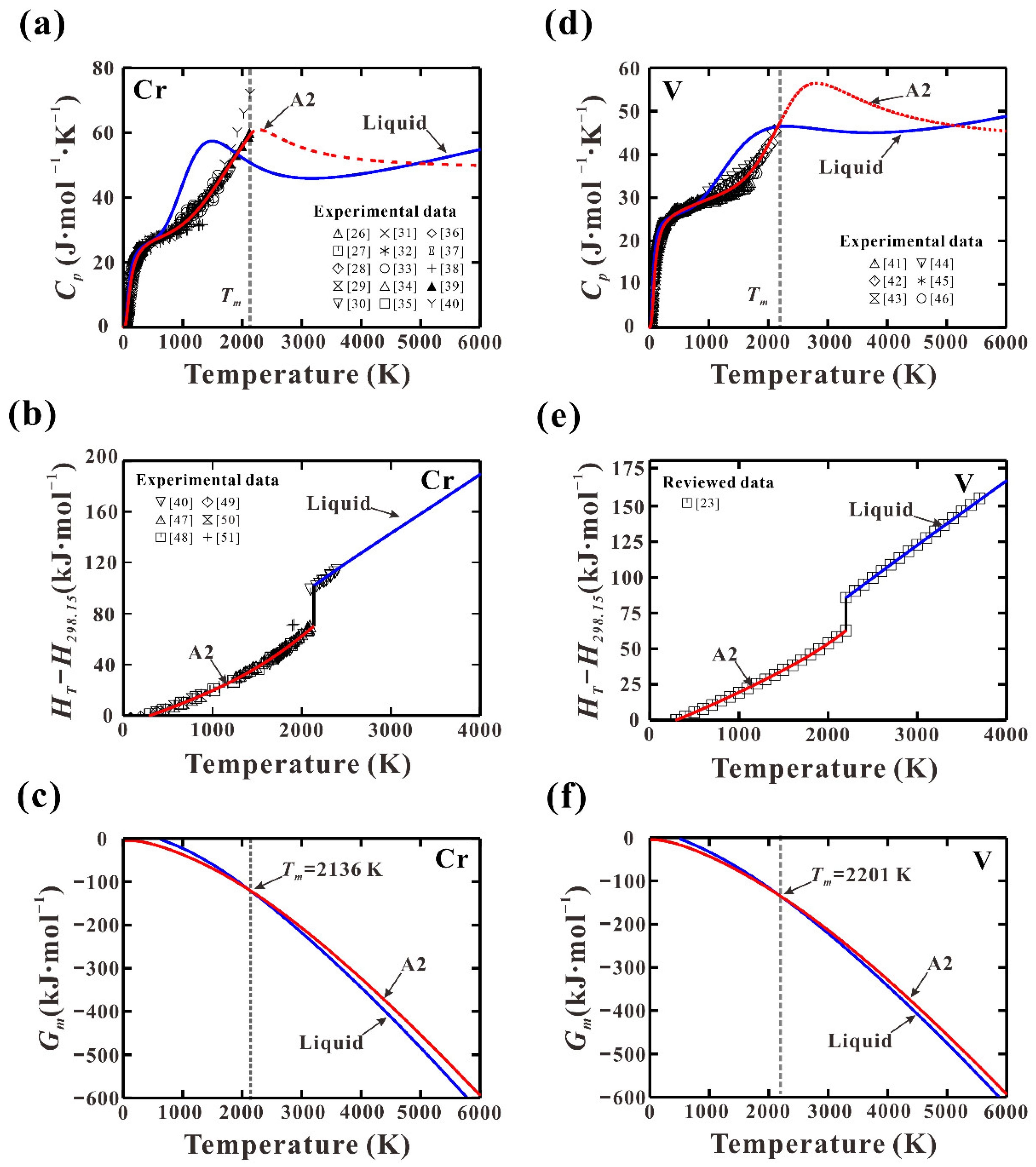
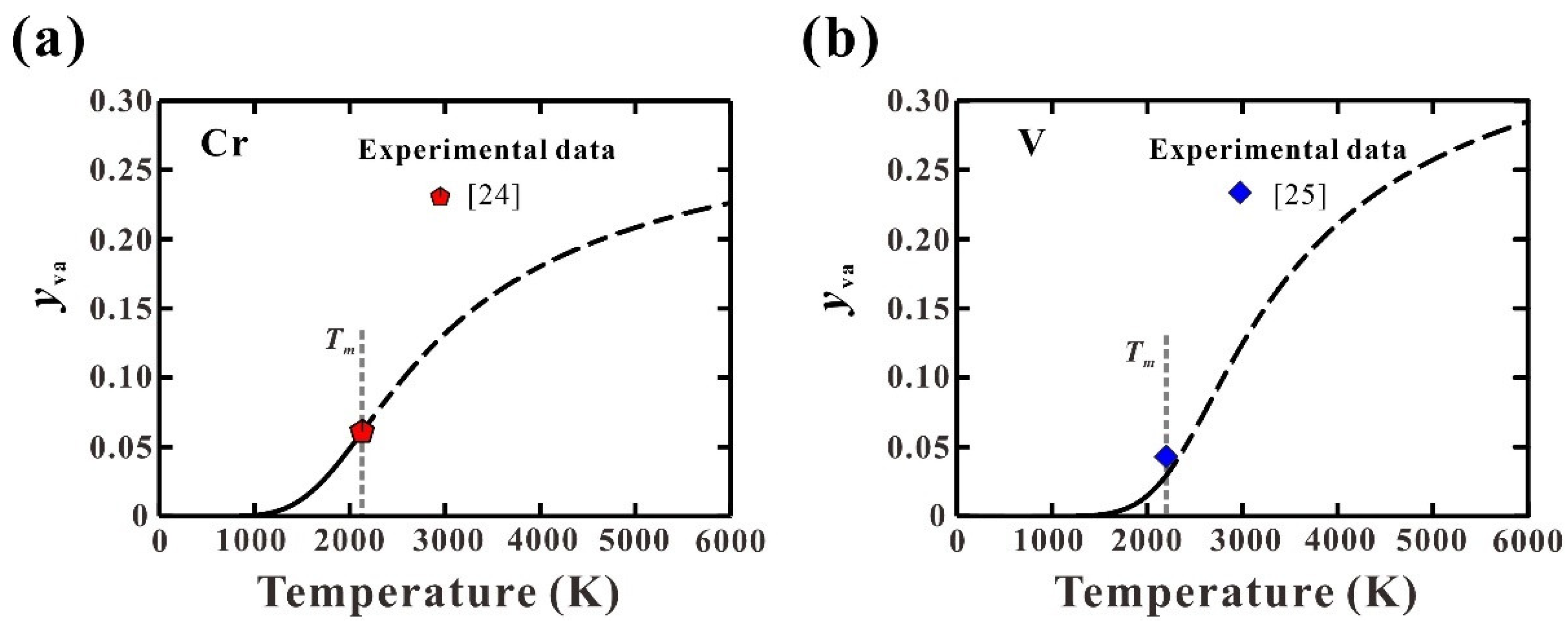
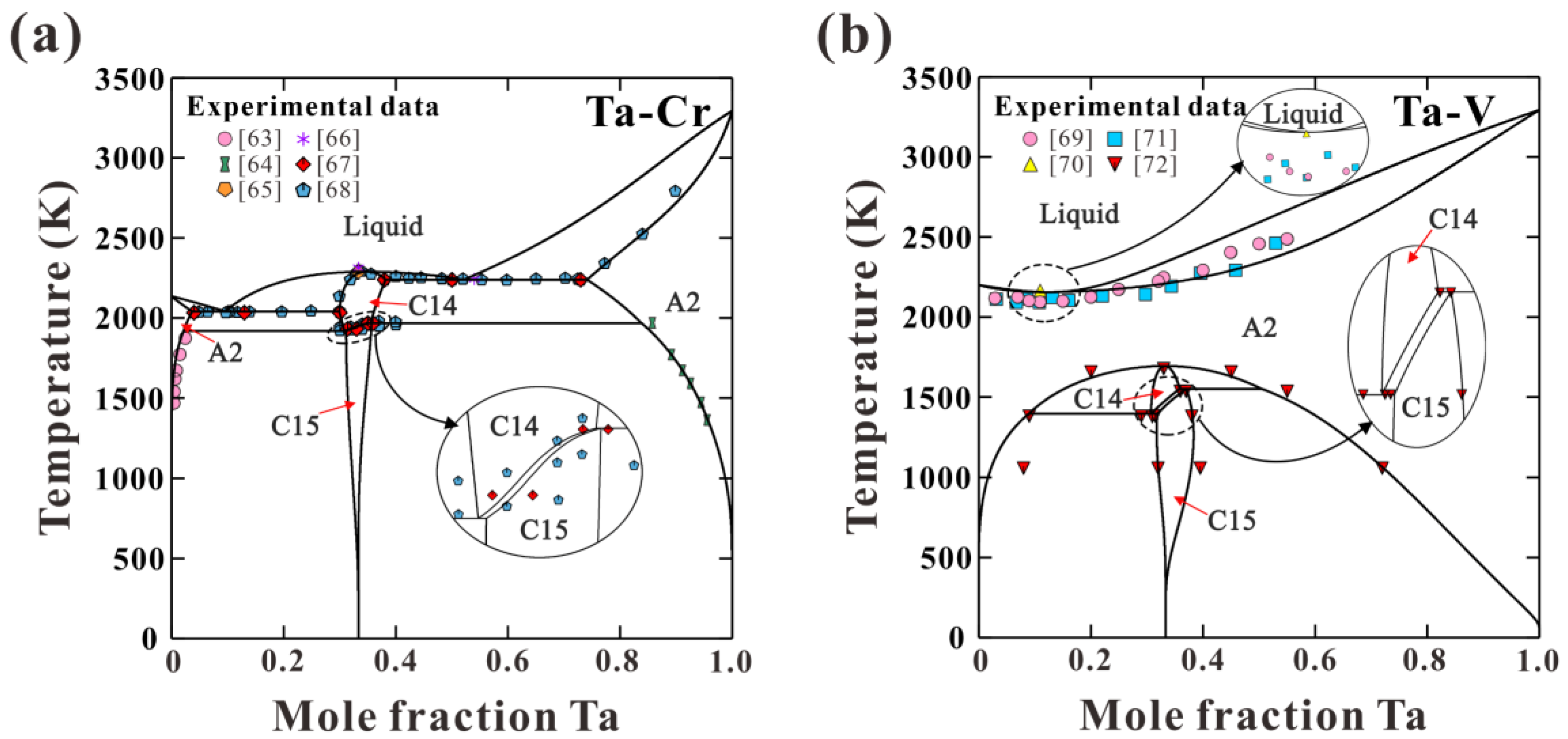
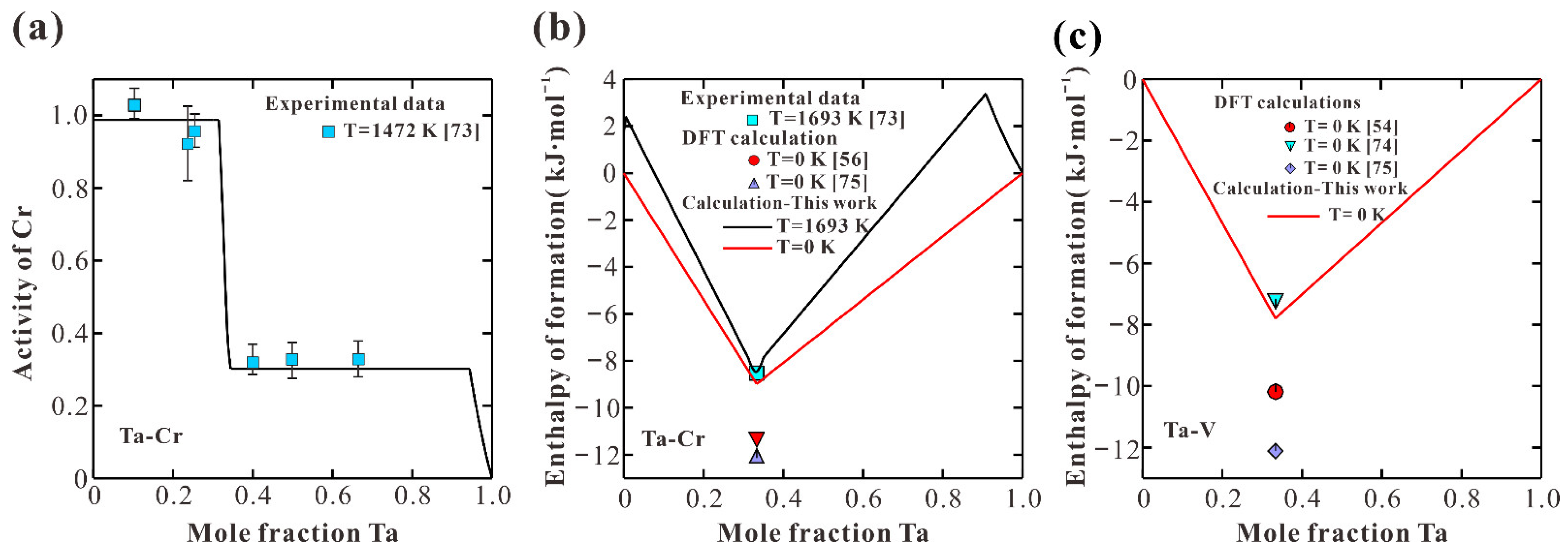
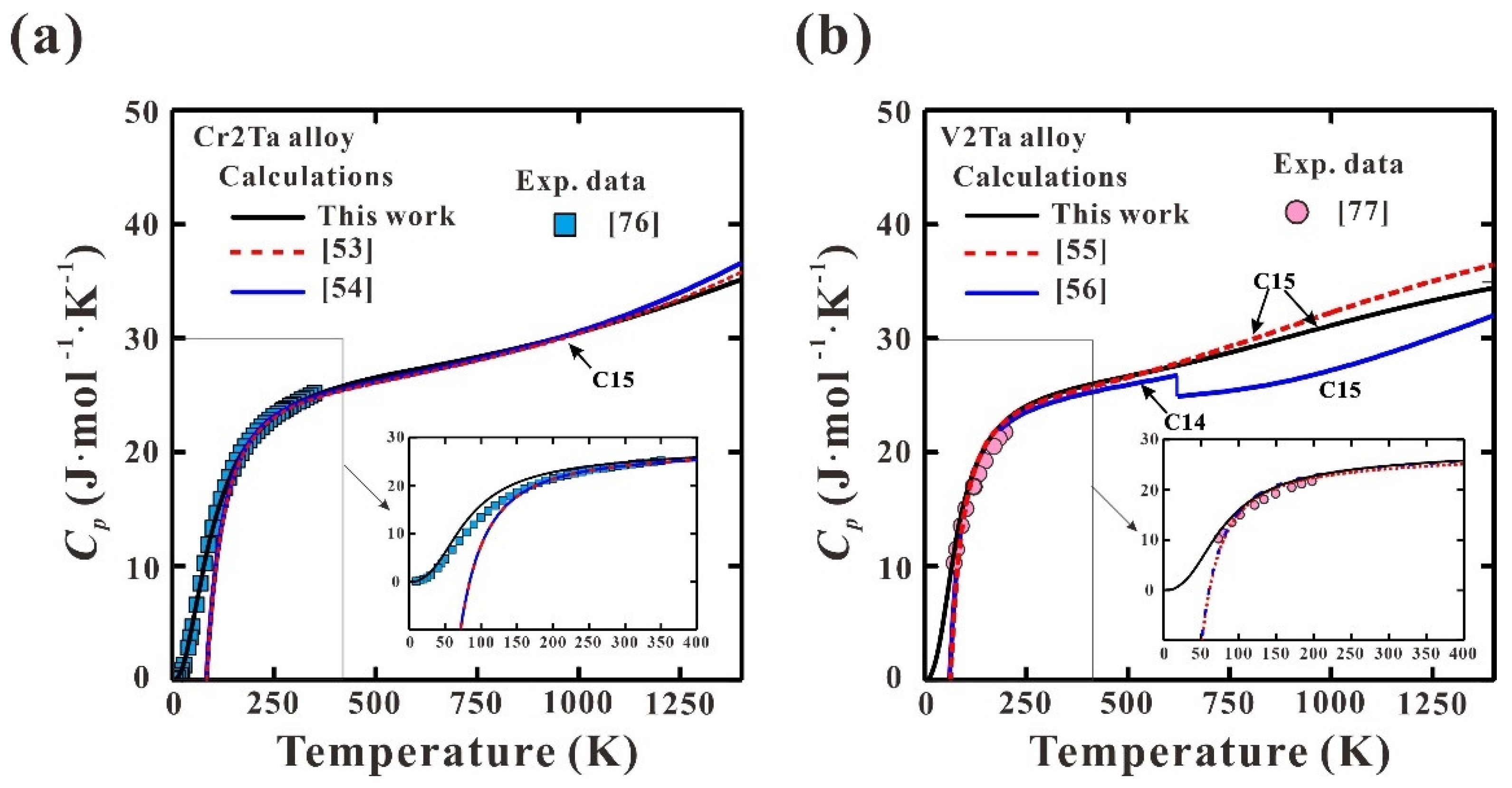
| Element | Phases | Gibbs Energy (J/mol) |
|---|---|---|
| Cr | A2 | |
| Liquid | ||
| V | A2 | |
| Liquid |
| Systems | Phases | Thermodynamic Parameters (J/mol) |
|---|---|---|
| Ta-Cr | Liquid | |
| A2 | ||
| C14 | ||
| C15 | ||
| Ta-V | Liquid | |
| A2 | ||
| C14 | ||
| C15 |
| Systems | Reactions | Temperature (K) | Composition (at. %Ta) | Ref. | ||
|---|---|---|---|---|---|---|
| Ta-Cr | Liquid → C14 | 2293.0 ± 20 | -- | 33.30 | -- | [67] (Exp.) |
| 2309.7 | -- | 34.90 | -- | [53] (Cal.) | ||
| 2304 | -- | 34.22 | -- | [54] (Cal.) | ||
| 2290.0 | -- | 34.87 | -- | This work (Cal.) | ||
| Liquid → A2(Cr) + C14 | 2033.0 ± 20 | ~13.00 | ~4.00 | ~30.00 | [67] (Exp.) | |
| 2040.0 ± 10 | ~10.50 | ~3.50 | ~30.00 | [68] (Exp.) | ||
| 2044.7 | 11.53 | 4.53 | 30.03 | [53] (Cal.) | ||
| 2065.1 | 9.88 | 3.89 | 30.65 | [54] (Cal.) | ||
| 2041.9 | 9.59 | 3.68 | 29.94 | This work (Cal.) | ||
| Liquid → A2(Ta) + C14 | 2238.0 ± 20 | ~50.0 | ~73.00 | ~38.00 | [67] (Exp.) | |
| 2223.4 | 49.41 | 72.75 | 37.90 | [53] (Cal.) | ||
| 2239.2 | 49.96 | 73.32 | 37.70 | [54] (Cal.) | ||
| 2239.0 | 52.12 | 74.13 | 38.21 | This work (Cal.) | ||
| C14 → A2(Cr) + C15 | 1933.0 | ~31.40 | -- | ~33.00 | [67] (Exp.) | |
| 1917.2 | 30.96 | 2.81 | 32.23 | [53] (Cal.) | ||
| 1903.3 | 30.97 | 1.87 | 31.11 | [54] (Cal.) | ||
| 1921.0 | 30.83 | 2.17 | 31.15 | This work (Cal.) | ||
| C14 + A2(Ta) → C15 | 1968.0 | ~35.00 | -- | ~36.00 | [67] (Exp.) | |
| 1982.9 | 35.17 | 80.58 | 35.55 | [53] (Cal.) | ||
| 1991.2 | 37.29 | 84.72 | 37.39 | [54] (Cal.) | ||
| 1969.0 | 35.52 | 83.86 | 35.72 | This work (Cal.) | ||
| Ta-V | Liquid → A2 | 2153.0 | -- | 11.00 | -- | [70] (Exp.) |
| 2098.0 | -- | 15.00 | -- | [69] (Exp.) | ||
| -- | -- | 12.00 | -- | [68] (Exp.) | ||
| 2099 | -- | 12.89 | -- | [55] (Cal.) | ||
| 2099 | -- | 12.89 | -- | [56] (Cal.) | ||
| 2156.0 | -- | 12.40 | -- | This work (Cal.) | ||
| A2 → C14 | 1693.0 | -- | ~33.00 | -- | [71] (Exp.) | |
| 1702.2 | -- | 32.70 | -- | [55] (Cal.) | ||
| 1703.3 | -- | 32.62 | -- | [56] (Cal.) | ||
| 1693.0 | -- | ~33.00 | -- | [72] (Exp.) | ||
| 1695.1 | -- | 33.22 | -- | This work (Cal.) | ||
| C14 + A2(Ta) → C15 | 1553.0 | 36.00 | 37.00 | 55.00 | [72] (Exp.) | |
| 1550.2 | 35.97 | 37.36 | 50.27 | [55] (Cal.) | ||
| 1556.1 | 36.14 | 37.78 | 57.21 | [56] (Cal.) | ||
| 1552.5 | 35.87 | 37.02 | 50.46 | This work (Cal.) | ||
| C14 → A2(V) + C15 | 1398.0 | 29.00 | 9.00 | 31.50 | [72] (Exp.) | |
| 1403.0 | 31.02 | 6.48 | 31.29 | [55] (Cal.) | ||
| 1409.5 | 30.69 | 3.41 | 31.64 | [56] (Cal.) | ||
| 1396.0 | 30.70 | 8.90 | 31.85 | This work (Cal.) | ||
Publisher’s Note: MDPI stays neutral with regard to jurisdictional claims in published maps and institutional affiliations. |
© 2022 by the authors. Licensee MDPI, Basel, Switzerland. This article is an open access article distributed under the terms and conditions of the Creative Commons Attribution (CC BY) license (https://creativecommons.org/licenses/by/4.0/).
Share and Cite
Zhang, E.; Xu, X.; Chen, Y.; Tang, Y. Third-Generation Thermodynamic Descriptions for Ta-Cr and Ta-V Binary Systems. Materials 2022, 15, 2074. https://doi.org/10.3390/ma15062074
Zhang E, Xu X, Chen Y, Tang Y. Third-Generation Thermodynamic Descriptions for Ta-Cr and Ta-V Binary Systems. Materials. 2022; 15(6):2074. https://doi.org/10.3390/ma15062074
Chicago/Turabian StyleZhang, Enkuan, Xinpei Xu, Yun Chen, and Ying Tang. 2022. "Third-Generation Thermodynamic Descriptions for Ta-Cr and Ta-V Binary Systems" Materials 15, no. 6: 2074. https://doi.org/10.3390/ma15062074
APA StyleZhang, E., Xu, X., Chen, Y., & Tang, Y. (2022). Third-Generation Thermodynamic Descriptions for Ta-Cr and Ta-V Binary Systems. Materials, 15(6), 2074. https://doi.org/10.3390/ma15062074







